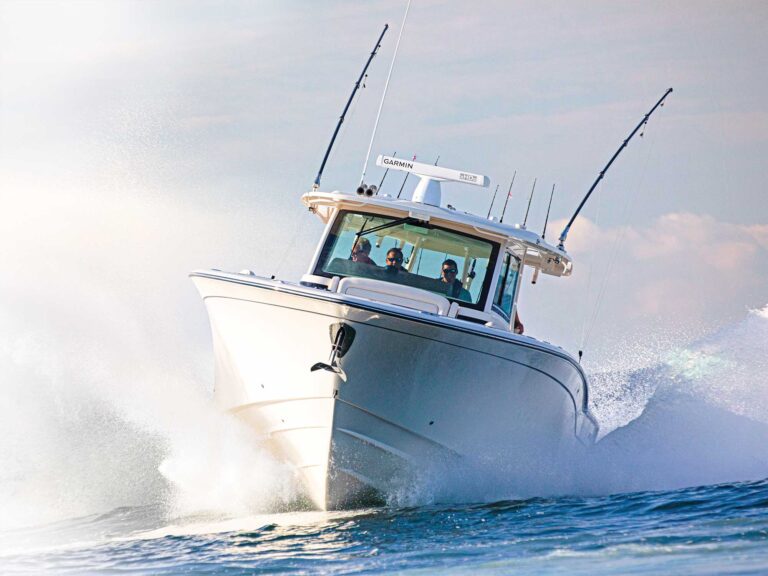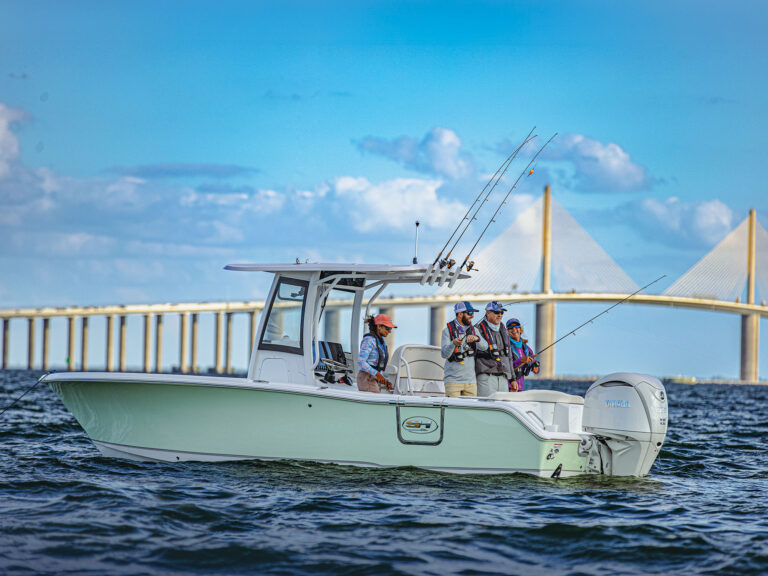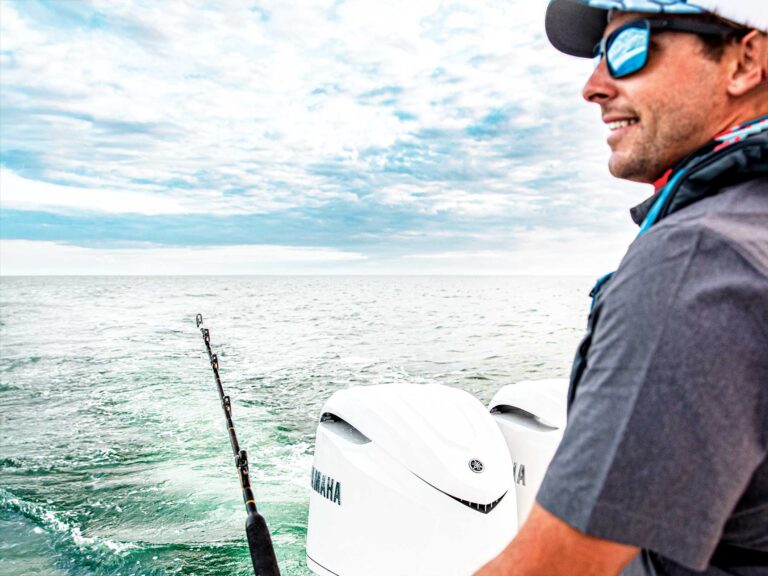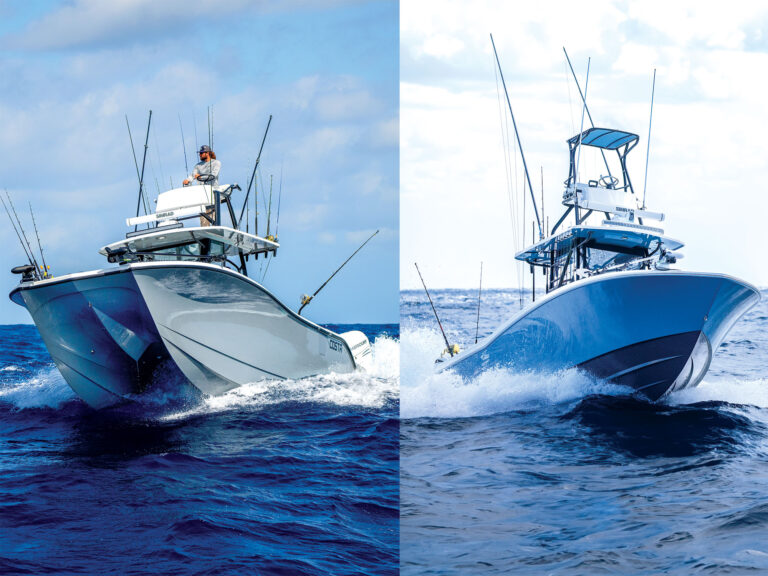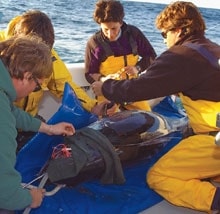
|| |—| || |TUNA TRACKER: Dr. Barbara Block, third from left, implants a tag in a giant bluefin. Photo: Scott Taylor| On a cold, blustery january day, Dr. Barbara Block was in the cockpit of a pitching sportfisherman off the coast of North Carolina, braving some of the worst conditions of the Atlantic. She kneeled at the side of giant bluefin tuna that lay docilely on the deck, carefully implanting an electronic tag.
And it’s not the first time. As a professor of marine science at Stanford University and founder and co-director of the Tuna Research and Conservation Center, Block and her team have worked with anglers off the Carolinas, Nantucket, Spain and Ireland and with longliners in the Gulf of Mexico to put archival tags in bluefin.
“Electronic tagging provides the best scientific information we’veever had to properly manage these tuna,” Block said. With the help of this sophisticated equipment and a satellite system, Block and her team have tagged more than 900 tuna and obtained data from nearly 400 of them to piece together a picture of how these fish use the ocean.
Atlantic bluefin stocks have decreased 80 percent or more in the last 30 years, and fishing effort and mortality remain at an all-time high. The data that Block and her team have compiled could help fisheries managers conserve and rebuild bluefin tuna in the western Atlantic, off the coast of North America. But the managers, such as the National Marine Fisheries Service (NMFS) and the International Commission for the Conservation of Atlantic Tunas (ICCAT), have not responded to her findings by changing regulations regarding bycatch, closing spawning areas to all longlining or keeping high-seas longliners out of feeding grounds.
Not Separate, Not Equal
Unless managers act, the future of the giant bluefin tuna that anglers pursue off the East Coast is in doubt.
“Our study indicates that there are management steps we could take today to ensure that giant bluefin tuna are swimming on the western side of the Atlantic basin tomorrow,” Block said. “It’s time for ICCAT to introduce management measures that recognize the fact that there is mixing of the two populations in both the west and east Atlantic, except on the spawning grounds.”
Western Atlantic bluefin-the fish American anglers target-spawn in the Gulf of Mexico, while the Eastern stock that swims in the waters off Europe spawns in the Mediterranean Sea. In 1982, ICCAT set up two management zones based on the best available scientific data, separated by a line at 45 degrees west longitude in the middle of the Atlantic Ocean.
Managers have known for some time that the western stock was in serious decline. The eastern stock, while still declining, was considered better off. Today, ICCAT limits the annual tuna catch in the western Atlantic to 3,000 tons while allowing a 32,000-ton quota in the Eastern Atlantic.
Here’s the challenge: Bluefin tagged off North America freely travel to the central Atlantic and even into European waters to feed. Block’s data shows that the two “separate” stocks frequently intermingle, and get caught and are incorrectly counted as part of the quota harvested near the other breeding stock’s native waters. Current ICCAT quotas allow large catches in the eastern Atlantic and fail to protect the troubled western bluefin.
Long Way to Go
“We can’t conserve the western Atlantic population without protecting these fish in the central Atlantic,” said Block. “Or, put another way, eastern fishers, particularly the high-seas longliners, may be impacting western recovery.” Managers have heard this before, because Block’s tagging data agrees with other information sources.
“Our tagging data, along with National Marine Fisheries Service observer data and longliner catch records, leave no doubt that we have a unique population of tuna spawning in the Gulf,” Block said. While these tuna spawn in the Gulf, there’s virtually no limit to their range.
Block’s study and these other data sources suggest that giant bluefin spawn from January to June in regions of the Gulf where powerful eddies bring nutrients to the surface. Since 1981, the Gulf breeding grounds have been closed to targeted bluefin fishing, but longliners after albacore, dolphin, bigeye and yellowfin are allowed to keep one bluefin for the first 2,000 pounds of fish landed, two for 6,000 pounds and three for 30,000 pounds or more. Many more giants are said to die on the hook and be thrown back dead.
Gulf longlining seems to be the perfect enemy of these endothermic, or warm-blooded, tuna that tire quickly in a warm environment.
“Being caught on a longline may be too much for breeding bluefin to tolerate,” Block said. During the team’s five research cruises aboard U.S. commercial longliners working in the Gulf, Block noted mortality levels of discarded bluefin were exceptionally high, even when caught on short sets-those with fewer than 200 circle hooks, soaking for less than two hours. According to NMFS data up to 1999, 80 percent of discarded bluefin tuna had died.
Two Solutions
“There are two ways to save declining bluefin stocks,” Block said. “Protect them in their feeding grounds and in their spawning grounds.” Immediate action is needed in the central Atlantic to reduce the mortality of foraging giants, and in the Gulf and Mediterranean where bluefin breed.
The Gulf spawning areas are located in the U.S. Exclusive Economic Zone under the jurisdiction of NMFS, which could close them to commercial longliners from January to June. But longliners are opposed and NMFS has not acted, despite the fact that it has acknowledged that the prohibition on directed fishing does not control bluefin bycatch and mortality.
ICCAT has not changed its regulations to acknowledge the mixing of the eastern and western Atlantic populations. And with the combined opposition of Gulf longliners and the Europeans, who are against reduced fishing quotas, few are optimistic that such protection will be realized.
“It’s really a triumph of technology, human effort and cooperation,” Block said of her study. “It would be extraordinarily disappointing if ICCAT and the U.S. government did not use the best available science and take immediate action to improve the status of the western stock.”
For information about Block’s tagging study, visit www.tunaresearch.org.
Longline Closure Denied
Deadly bycatch will continue in the Gulf.
After Dr. Barbara Block released her data in April 2005, environmental groups Oceana and Earthjustice filed a petition to protect tuna in nearly 125,000 square miles of the northern Gulf. Filed on behalf of other environmental groups, the suggested ban on longlining was opposed by commerccial fishermen who said it would keep them from the best waters. In December, the National Marine Fisheries Service (NMFS) rejected the petition, claiming the closure would result in redistributed fishing effort and increased bycatch of bluefin, billfish and sea turtles. Angling groups disagreed with the assessment. “It would be better to see NMFS figuring out what they can do to save this animal,” said Dr. Carl Safina of the Blue Ocean Institute. “Instead of what they can’t do.”
– J.M.





